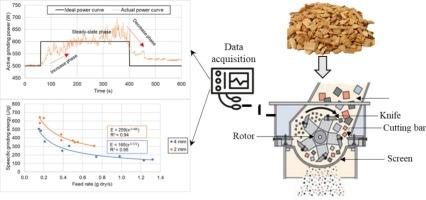Analysis of size reduction data from applying knife mill to assess the grindability index for woody biomass
IF 4.6
2区 工程技术
Q2 ENGINEERING, CHEMICAL
引用次数: 0
Abstract
Wood chips must undergo a crucial step of size reduction to attain suitable particle sizes for downstream processing to biofuel and bioenergy production. The ISO technical committee 238 is developing a grinding index method for cellulosic biomass. Wood chips are typically ground to particle sizes below 2 mm. We ground beech wood chips in a knife mill at varying feed rate with screen aperture size of 0.5 to 4 mm to understand the effect of feed rate on the energy consumption and the product particle size. Rittinger's and Holmes equations were fitted to the specific grinding energy data and were equally well suited to describe the energy consumption pattern. When increasing feed rate from 0.2 to 1.4 g/s while grinding on a screen aperture size of 4 mm, specific grinding energy decreased from 500 J/g to 150 J/g and the mean particle size increased from 0.79 mm to 1.02 mm.

应用刀磨机评估木质生物质可磨性指标的减粒度数据分析
木屑必须经过缩小尺寸的关键步骤,以获得适合下游加工的生物燃料和生物能源生产的颗粒尺寸。ISO 238技术委员会正在开发一种纤维素生物质的研磨指数方法。木屑通常被磨成小于2毫米的粒度。以不同进给量的山毛榉木屑在刀磨机中研磨,筛孔尺寸为0.5 ~ 4mm,了解进给量对能耗和产品粒度的影响。Rittinger’s和Holmes方程拟合到具体的磨削能量数据,同样适合于描述能量消耗模式。在筛孔尺寸为4 mm时,将给料量从0.2增加到1.4 g/s,比磨能从500 J/g下降到150 J/g,平均粒度从0.79 mm增加到1.02 mm。
本文章由计算机程序翻译,如有差异,请以英文原文为准。
求助全文
约1分钟内获得全文
求助全文
来源期刊

Powder Technology
工程技术-工程:化工
CiteScore
9.90
自引率
15.40%
发文量
1047
审稿时长
46 days
期刊介绍:
Powder Technology is an International Journal on the Science and Technology of Wet and Dry Particulate Systems. Powder Technology publishes papers on all aspects of the formation of particles and their characterisation and on the study of systems containing particulate solids. No limitation is imposed on the size of the particles, which may range from nanometre scale, as in pigments or aerosols, to that of mined or quarried materials. The following list of topics is not intended to be comprehensive, but rather to indicate typical subjects which fall within the scope of the journal's interests:
Formation and synthesis of particles by precipitation and other methods.
Modification of particles by agglomeration, coating, comminution and attrition.
Characterisation of the size, shape, surface area, pore structure and strength of particles and agglomerates (including the origins and effects of inter particle forces).
Packing, failure, flow and permeability of assemblies of particles.
Particle-particle interactions and suspension rheology.
Handling and processing operations such as slurry flow, fluidization, pneumatic conveying.
Interactions between particles and their environment, including delivery of particulate products to the body.
Applications of particle technology in production of pharmaceuticals, chemicals, foods, pigments, structural, and functional materials and in environmental and energy related matters.
For materials-oriented contributions we are looking for articles revealing the effect of particle/powder characteristics (size, morphology and composition, in that order) on material performance or functionality and, ideally, comparison to any industrial standard.
 求助内容:
求助内容: 应助结果提醒方式:
应助结果提醒方式:


